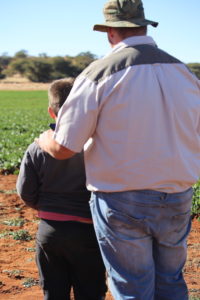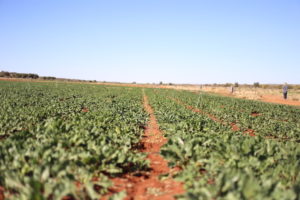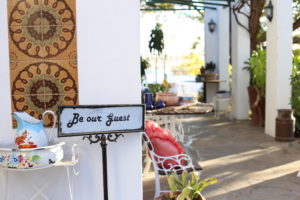Over the past week, many Namibian land owners opened their doors and allowed us a firsthand look into their livelihoods. Land ownership in Namibia vastly differs from land ownership in the United States. According to Brian Child, Chair of the Southern Africa Sustainable Use Specialist Group, 44 percent of all land is owned by private land owners, 41 percent is communally-owned, and 15 percent is state-owned, such as in the national parks. Many of Namibia’s diverse ethnic tribes call communal lands home, while private land owners make their living as farmers and business owners.
Jimmy O’Kennedy, owner and operator of Patria Farms, gave our group a private tour of his commercial fruit, vegetable, and livestock farm in Stampriet. Though Namibia is experiencing a severe drought, Jimmy’s 40 hectares of luscious green vegetables show no sign of water deprivation. Patria Farms is fortunately located on the Stampriet Artesian Aquifer Basin, allowing for fertile soils and the ability to implement highly advanced drip irrigation systems.
Patria Farms has been in operation since the 1900s. From a young age, Jimmy said his father encouraged involvement on the farm. Now Jimmy is doing the same for his younger brother, Willy. Patria Farms employs 45 people regularly and more during harvest. I was fascinated to learn that they still implement many old fashioned farming practices, such as weeding and harvesting vegetables by hand, which are long-gone practices in most American commercial farms.
Despite Jimmy’s lifelong farm training, Patria Farms still faces challenges common to all Namibian farmers. The arid soils and lack of water make farming difficult. Livestock can be easily lost to predators and thieves. Another issue facing Namibians is the Land Redistribution Act of Government. If a landowner wants to sell land, it must first be offered to the government. Through the Land Redistribution Act, state-purchased land is then sold to a previously disadvantaged person. Even with the drive to succeed, many of these new land owners do not have and/or cannot access proper training or education to ensure success. Lack of education leads to more subsistence, rather than commercial farming; Namibia needs successful commercial farmers to decrease the country’s reliance on food imports.
While in Stampriet, we lodged at the Stampriet Historical Guesthouse. During our tour with Jimmy, I learned that his father actually built the beautiful guest house. The O’Kennedy’s no longer own it, however many facets, such as antique furniture and old photographs hanging high on the walls, are original pieces from the O’Kennedy family. Like Kobus and Petro Hayman, owners of the Stampriet Historical Guesthouse, some Namibian land owners make their livings in the tourism industry. Namibia is diverse in both landscape and culture, drawing in visitors worldwide.
Namibians won the fight for freedom only 26 years ago and remain resilient in their efforts toward progression. By submerging myself in parts of Namibian culture the past week, I am gaining a greater appreciation for the simple rights and freedoms I often take for granted in America. The next time I am home, in Somerset, Pennsylvania, I will cherish the land that has been the foundation of my life.


